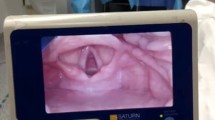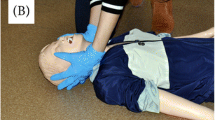Abstract
Purpose
A non-line-of-sight view is expected to cause less movement of the anterior airway anatomy and cervical spine during laryngeal visualization. Reduced distortion of anterior airway anatomy during laryngoscopy with the GlideScope videolaryngoscope (GVL), compared with the Macintosh laryngoscope, could explain the relatively easier nasotracheal intubation with the GVL. The purpose of this radiographic study was to compare the degree of anterior airway distortion and cervical spine movement during laryngoscopy with the GVL and the conventional Macintosh laryngoscope.
Methods
Twenty patients requiring general anesthesia and tracheal intubation were studied. Each patient underwent laryngoscopy using the first-generation GVL and a direct laryngoscope with a Macintosh blade. During each laryngoscopy, a radiograph was taken when the best view of the larynx was obtained. Independent radiologists with subspeciality training in musculoskeletal imaging evaluated anterior airway distortion and cervical spine movement.
Results
The distance between the epiglottis and the posterior pharyngeal wall during the GlideScope procedure was 21% less than that during the Macintosh laryngoscopy (P < 0.05). Anterior deviations of the vertebral bodies from baseline were 27, 32, 36, and 39% less at the atlas, C2, C3, and C4 vertebrae, respectively, during the GlideScope procedure than those measured during Macintosh laryngoscopy (P < 0.01). Cervical extension between the occiput and C4 during the GlideScope procedure was 23% less than that during Macintosh laryngoscopy (P < 0.05).
Conclusion
Both anterior airway distortion and cervical spine movement during laryngeal visualization were less with the GVL than with the Macintosh laryngoscope.







Similar content being viewed by others
References
Hirabayashi Y. GlideScope videolaryngoscope facilitates nasotracheal intubation. Can J Anesth. 2006;53:1163–4.
Xue F, Zhang G, Liu J, Li X, Sun H, Wang X, Li C, Liu K, Xu Y, Liu Y. A clinical assessment of the GlideScope videolaryngoscope in nasotracheal intubation with general anesthesia. J Clin Anesth. 2006;18:611–5.
Jones PM, Armstrong KP, Armstrong PM, Cherry RA, Harle CC, Hoogstra J, Turkstra TP. A comparison of GlideScope videolaryngoscopy to direct laryngoscopy for nasotracheal intubation. Anesth Analg. 2008;107:144–8.
Hirabayashi Y, Fujita A, Seo N, Sugimoto H. A comparison of cervical spine movement during laryngoscopy using the Airtraq or Macintosh laryngoscopes. Anaesthesia. 2008;63:635–40.
Hirabayashi Y, Fujita A, Seo N, Sugimoto H. Cervical spine movement during laryngoscopy using the Airway Scope compared with the Macintosh laryngoscope. Anaesthesia. 2007;62:1050–5.
Hastings RH, Vigil AC, Hanna R, Yang BY, Sartoris DJ. Cervical spine movement during laryngoscopy with the Bullard, Macintosh and Miller laryngoscopes. Anesthesiology. 1995;82:859–69.
Watts AD, Gelb AW, Bach DB, Pelz DM. Comparison of the Bullard and Macintosh laryngoscopes for endotracheal intubation of patients with a potential cervical spine injury. Anesthesiology. 1997;87:1335–42.
Wong DM, Prabhu A, Chakraborty S, Tan G, Massicotte EM, Cooper R. Cervical spine motion during flexible bronchoscopy compared with the Lo-Pro GlideScope. Br J Anaesth. 2009;102:424–30.
Robitaille A, Williams SR, Tremblay M-H, Guilbert F, Thériault M, Drolet P. Cervical spine motion during tracheal intubation with manual in-line stabilization: direct laryngoscopy versus GlideScope videolaryngoscopy. Anesth Analg. 2008;106:935–41.
Turkstra TP, Craen RA, Pelz DM, Gelb AW. Cervical spine motion: a fluoroscopic comparison during intubation with lighted stylet, GlideScope, and Macintosh laryngoscope. Anesth Analg. 2005;101:910–5.
Acknowledgment
The authors thank the radiology technologists at Jichi Medical University Hospital.
Author information
Authors and Affiliations
Corresponding author
About this article
Cite this article
Hirabayashi, Y., Fujita, A., Seo, N. et al. Distortion of anterior airway anatomy during laryngoscopy with the GlideScope videolaryngoscope. J Anesth 24, 366–372 (2010). https://doi.org/10.1007/s00540-010-0927-0
Received:
Accepted:
Published:
Issue Date:
DOI: https://doi.org/10.1007/s00540-010-0927-0




